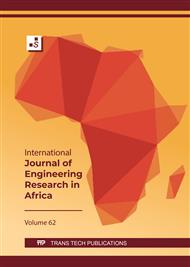[1]
M. Chappat et J. Bilal, « La route écologique du futur - Consommation d'énergie et émission de gaz à effet de serre », COLAS, (2003).
Google Scholar
[2]
T. Pierre Dorchies, « La route écologique du futur: Analyse de la consommation d'énergie et des émissions de gaz à effet de serre ». ColasCanada (Sintra Inc.), (2008).
DOI: 10.1787/9789264097353-8-fr
Google Scholar
[3]
Céline Lenglet, Sarah Goyer, Thibaut Lambert, Arnaud Feeser, et Jean Fauqué, « Etude des éco-comparateurs Synthèse des études de cas Phase 1 », CEREMA, (2014).
Google Scholar
[4]
Thives, L. P., Ghisi, E., Asphalt mixtures emission and energy consumption: A review,, Renewable and Sustainable Energy Reviews, 72, (2017), 473-484.
DOI: 10.1016/j.rser.2017.01.087
Google Scholar
[5]
T. Hoang, « Tronçons autoroutiers : une méthodologie de modélisation environnementale et économique pour différents scénarios », PhD dissertation, Nantes, (2005).
Google Scholar
[6]
T. Blomberg et al., « Partial life cycle inventory or eco-profile, for paving grade bitumen », European Bitumen Association (In.), Brussels, Belgium. Eurobitume report, 99, (1999).
Google Scholar
[7]
Athena Institute, « A life cycle perspective on concrete and asphalt roadways: embodied primary energy and global warming potential », (2006).
Google Scholar
[8]
H. Stripple, « Life Cycle Assessment of Road- A Pilot Study for Inventory Analysis », IVL Swedish Environmental Research Institute, Second Revised Edition, (2001).
Google Scholar
[9]
Y. H. Huang, Pavement analysis and design, 2nd ed. Upper Saddle River, NJ: Pearson/Prentice Hall, (2004).
Google Scholar
[10]
P. Gauthier, « Étude du concept de structure inverse pour le renforcement de chaussées soumises aux charges d'autobus urbains », PhD Thesis, Université Laval, (2011).
Google Scholar
[11]
South African National Roads Agency (SANRAL), South African pavement engineering manual. Pretoria: SANRAL, (2013).
Google Scholar
[12]
E. Tutumluer and R. D. Barksdale, « Inverted flexible pavement response and performance », Transportation research record, 1482, (1995), 102‑110.
Google Scholar
[13]
E. Tutumluer, « Predicting behavior of flexible pavements with granular bases », (1995).
Google Scholar
[14]
J.-F. Corté and M.-T. Goux, « Design of Pavement Structures: The French Technical Guide », Transportation Research Record No. 1539, Flexible Pavement Design and Rehabilitation Issues, (1996), 116-124.
DOI: 10.1177/0361198196153900116
Google Scholar
[15]
AFNOR, NF P98-086, Dimensionnement structurel des chaussées routières- Application aux chaussées neuves, (2019).
DOI: 10.51257/a-v1-c4316
Google Scholar
[16]
ISO 14040, Environmental Management – Life-Cycle Assessment - Principles and Framework (ISO 2006a).
DOI: 10.1065/lca2005.03.001
Google Scholar
[17]
Harvey, J., Meijer, J., Ozer, H., Al-Qadi, I. L., Saboori, A., & Kendall, A. « Pavement life cycle assessment framework », No. FHWA-HIF-16-014,. United States, Federal Highway Administration, (2006).
Google Scholar
[18]
ISO 14044, Environmental Management – Life-Cycle Assessment Requirements and Guidelines (ISO 2006b).
DOI: 10.3403/30290345
Google Scholar
[19]
« éco-comparateur ECORCE2 », 2012. http://ecorce2.ifsttar.fr/use.php.
Google Scholar
[20]
A. Ventura, M. Dauvergne, A. Jullien, et P. Tamagny, « ECORCE 1.0 : Eco-comparateur routes, construction et entretien », Revue générale des Routes RGRA, 883, (2010).
Google Scholar
[21]
S. Nocera, O. I. Galati, and F. Cavallaro, « On the Uncertainty in the Economic Valuation of Carbon Emissions from Transport », Journal of Transport Economics and Policy, 52, (2018).
Google Scholar
[22]
International Bank for Reconstruction and Development, the World Bank, Carbon Pricing Leadership Coalition, Carbon Pricing Leadership Report, Washington DC, (2020).
Google Scholar


